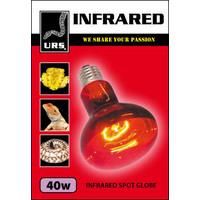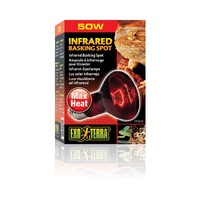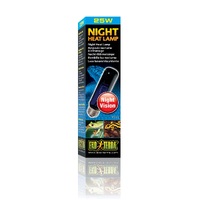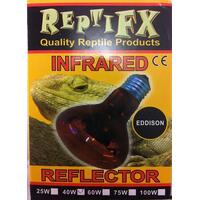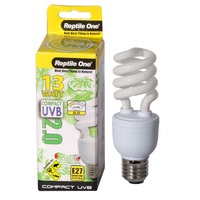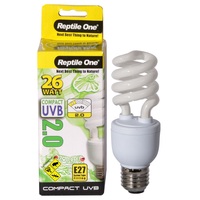Reptile Heat & Infrared Bulbs
Keep your scaly pet warm & healthy with our range of reptile heat bulbs. We stock a wide range of infrared heat lamps for reptiles. Infrared heat lights give a soft light to humans, but are not visible to lizards, so are perfect for nighttime use! Shop our range of reptile heat lights online.
Reptile Heat Bulb FAQ's
What is a reptile heat bulb?
A reptile heat bulb is a type of light bulb designed specifically for reptiles. It emits heat and light, mimicking the natural sunlight that reptiles need for their well-being.
Why do reptiles need heat bulbs?
Reptiles are cold-blooded animals, meaning they rely on external heat sources like the sun to regulate their body temperature. In captivity, heat bulbs are required and provide the necessary warmth for reptiles to maintain their metabolism, digestion, and overall health.
What wattage should I use for the heat bulb?
The wattage of the heat bulb depends on the size of the enclosure, the species of reptile, and the temperature gradient needed. It's important to research the specific requirements of your reptile species and consult a reptile expert or vet for advice on the appropriate wattage. We also strongly recommend using a thermostat in conjunction with any heat source you have for your reptile. This ensures the heat source does not overheat, and stays at the temperature you have set.
How long should I keep the heat bulb on?
This can be species specific, however as a general rule of thumb we recommend providing your reptile with a 12-hour light and heat cycle, to mimic their natural environment and light cycle.
Where should I position the heat bulb in the enclosure?
The placement of your heat bulb depends on multiple things, the enclosure size and the species of reptile you are keeping. Regardless of the species, all reptiles are required to thermoregulate, so they all require a temperature gradient within the enclosure. This is done by placing the heat source on one side/end of the enclosure, leaving the other side without heat to create an area that is cooler than the side with the direct heat source. This allows your reptile to thermoregulate by residing to either side it feels it requires. Some reptiles also need UVB bulbs, so for this reason, placing your heat source on one side of the enclosure still gives you room to install a UVB bulb on the other side.
How often should I replace my heat bulb?
Different brands of bulbs generally have different lifespans. Without the use of a thermostat, standard heat bulbs will generally need replacing monthly. Always replace your bulb if it has blown, or if the thermostat it is hooked up to is showing you the heat output is not at what you have set, indicating the bulb may need replacing.
What is an infrared bulb?
An infrared lamp is a type of heat bulb that emits infrared heat. It provides a direct and focused heat source for reptiles. Infrared lamps are commonly used for reptiles that require supplemental heat without disturbing their natural day-night cycle. Infrared bulbs emit around 96% heat, compared to around 50% of traditional bulbs. For this reason, it is extremely important to always use a thermostat in conjunction with the infrared bulb to diminish the risk of the enclosure overheating.
Why do reptiles need an infrared bulb?
Reptiles are cold-blooded animals, which means they rely solely on the heat from the sun to regulate their body temperature. Infrared bulbs emit heat in the form of infrared heat, which can penetrate the skin and warm the reptile's body directly. This helps them maintain their metabolism, digestion, and overall well-being.
How does an infrared bulb differ from other reptile heat sources?
Unlike other heat sources such as incandescent bulbs or ceramic heat emitters, infrared bulbs emit heat in the form of infrared radiation rather than visible light. This makes them suitable for reptiles that are sensitive to light or for use during the night when darkness is important.
What are the benefits of using an infrared lamp for reptile?
Infrared bulbs have several benefits. First, they emit direct heat, allowing reptiles to bask directly underneath the lamp and absorb the warmth they need. Second, since infrared bulbs do not emit visible light, they can be used during the night for nocturnal reptiles without disrupting their natural behaviour. They are also commonly used as brooding lamps for young birds, or birds which are sick or recovering from injury.
What type of reptiles would benefit from an infrared lamp?
Reptiles that spend a lot of time basking, such as bearded dragons, blue tongue skinks and certain snake species etc. Infrared bulbs produce low light, so any reptile that is sensitive to light will also benefit from infrared bulbs.
Do infrared lamps provide UVB light?
No, infrared lamps do not emit UVB light. UVB light is necessary for reptiles that require it for vitamin D synthesis and calcium metabolism. If your reptile species requires UVB, you would need to provide a separate UVB light source in addition to the infrared lamp.
Related categories: Reptile Light Bulbs, Reptile Night Lights, Reptile Basking Bulbs, Reptile Daylight Bulbs, Reptile Heat Mats, Reptile Temperature Reading, Reptile Thermostats, Reptile Reflectors, Reptile Cage Covers, Reptile Lights, Reptile Heating
Popular reptile heat bulb brands: Exo Terra, ReptiFX, Reptile One, URS, Zoo Med
Checkout with Afterpay, Zippay, Visa, Mastercard or American Express.

 for Dog Products & Supplies
for Dog Products & Supplies
 for Dog Food
for Dog Food
 for Cat Products & Supplies
for Cat Products & Supplies
 for Cat Food
for Cat Food
 for Reptiles
for Reptiles
 for Small Animals
for Small Animals
 for Aquarium
for Aquarium
 for Bird Products & Supplies
for Bird Products & Supplies
